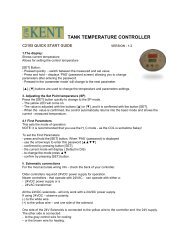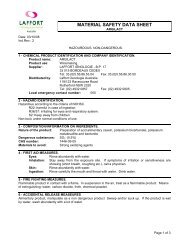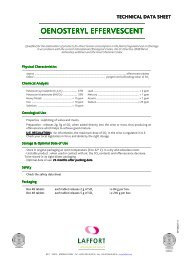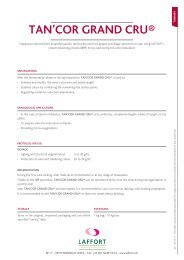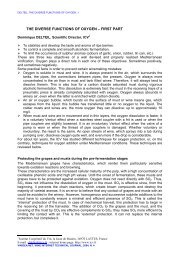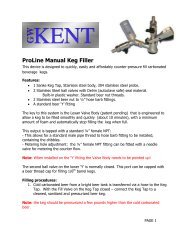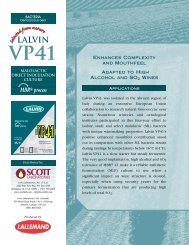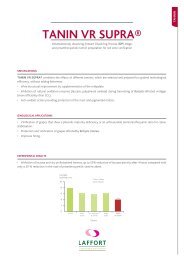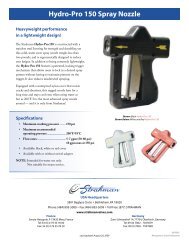HI 83748 Photometer - TERM-minator
HI 83748 Photometer - TERM-minator
HI 83748 Photometer - TERM-minator
Create successful ePaper yourself
Turn your PDF publications into a flip-book with our unique Google optimized e-Paper software.
<strong>HI</strong> <strong>83748</strong> <strong>Photometer</strong><br />
FOR THE DE<strong>TERM</strong>INATION OF TARTARIC ACID IN WINE
<strong>HI</strong> <strong>83748</strong><br />
<strong>Photometer</strong><br />
FOR THE DE<strong>TERM</strong>INATION OF<br />
TARTARIC ACID IN WINE $<br />
495 .00<br />
Tartaric Acid: Wine Acidity.<br />
Acids in wine are present in the must or are<br />
the result of fermentation.<br />
Acids originated from the must are:<br />
- Tartaric Acid;<br />
- Malic Acid;<br />
- Citric Acid.<br />
Acids originated from fermentation are:<br />
- Succinic Acid;<br />
- Acetic Acid;<br />
- Lactic Acid.<br />
Of all these acids, tartaric acid is the<br />
strongest and contains the most salts.<br />
During the process of transformation from<br />
must to wine, the concentration of tartaric<br />
acid is lowered because of the precipitation<br />
of potassium bitartrate which is caused by<br />
the increase of the alcoholic grade and the<br />
decrease of the temperature.<br />
Malic acid is very commonly found in<br />
nature, and it is metabolize by a number of<br />
different organisms. Citric acid is least commonly<br />
found acid in must.<br />
Wine acidity can be divided in:<br />
- Fixed acidity: it is the result of non<br />
volatile acids, acids that do not distill (tartaric<br />
acid, malic acid, citric acid, Succinic acid).<br />
- Volatile acidity: it is the result of volatile<br />
acids, acids that are separated by steam<br />
volatilization (acetic acid, lactic acid)<br />
- Total acidity: it is the result of the fixed<br />
acidity and the volatile acidity combined.<br />
ESTIMATED RETAIL PRICE
Tartaric Acid: “Acidity of Wine”<br />
Total acidity and fixed acidity of wine are<br />
expressed in grams of tartaric acid per liter of<br />
wine. Volatile acidity is expressed in grams of<br />
acetic acid per liter of wine. Wine acidity is pH<br />
dependent. During wine tasting the acid “note” is<br />
affected by pH. Tartaric acid is found naturally in<br />
grapes. The content of tartaric acid in grapes<br />
varies from region to region and is typically lower<br />
in sunny regions where the grapes are exposed<br />
to warmer temperatures (combustion). Typically,<br />
this gives wine the pH value of 3 to 3.5. Tartaric<br />
acid provides wine a sensation of freshness,<br />
while a wine with insufficient tartaric acid is “without<br />
body”. The precipitation of calcium and potassium<br />
salts diminishes tartaric acid in time. It is very<br />
important to keep tartaric acid monitored and<br />
stable. HANNA’s <strong>HI</strong> <strong>83748</strong> is an invaluable instrument<br />
to monitoring this crucial parameter in the<br />
process of wine making. With a few simple steps<br />
wine makers can quickly and accurately measure<br />
tartaric acid content in wine directly in g/L.<br />
4 Easy Steps to Measuring<br />
Tartaric Acid in Wine<br />
1<br />
2<br />
3<br />
4<br />
Prepare the sample to<br />
be measured with 200<br />
µl of wine and 5 ml of<br />
reagent A.<br />
Zero the instrument<br />
with the prepared<br />
sample.<br />
Add reagent B and<br />
allow to react.<br />
Read the concentration of<br />
tartaric acid expressed in<br />
g/L.<br />
Optical system of <strong>HI</strong> <strong>83748</strong><br />
The <strong>HI</strong> <strong>83748</strong> uses a tungsten light<br />
source and a narrow band filter of<br />
525 nm<br />
Tungsten Lamp<br />
Lens<br />
Cuvet<br />
Filter<br />
Light Detector<br />
Microprocessor
<strong>HI</strong> <strong>83748</strong> <strong>Photometer</strong><br />
FOR THE DE<strong>TERM</strong>INATION OF TARTARIC ACID IN WINE<br />
Ordering Information<br />
<strong>HI</strong> <strong>83748</strong> is supplied complete with reagents for 5 tests, 200 µl<br />
pipette, 5 mL syringe, (2) cuvets with caps, tissue for wiping<br />
cuvets, 12 VDC power adapter, (4) 1.5V AA batteries and<br />
instruction manual in a hard carrying case.<br />
Specifications<br />
<strong>HI</strong> <strong>83748</strong> Tartaric Acid <strong>Photometer</strong><br />
Range<br />
0.0 to 5.0 g/L<br />
Accuracy Typical ±5%<br />
Light Source<br />
Tungsten lamp with narrow band interference filter @ 525 nm<br />
Sensor<br />
Silicon photocell<br />
Method<br />
The reaction of tartaric acid with the reagent causes the sample to turn orange/yellow<br />
Environment<br />
0 to 50°C; max 95% RH non-condensing<br />
Battery Type<br />
(4) 1.5V AA batteries/12 VDC adapter<br />
Auto Shut-off<br />
After 15 minutes of non-use<br />
Dimensions<br />
225 x 85 x 80 mm<br />
Weight<br />
500 g<br />
Recommended Accessories<br />
<strong>HI</strong> <strong>83748</strong>-20 Tartaric acid reagents (20 tests)<br />
<strong>HI</strong> 731318 Cuvet tissue (4 pcs)<br />
<strong>HI</strong> 731340 200 µL pipette<br />
<strong>HI</strong> 731350 200 µL pipette tips (25 pcs)<br />
<strong>HI</strong> 731321 Glass cuvets (4 pcs)<br />
<strong>HI</strong> 710006 12 VDC power supply<br />
Authorized Distributor<br />
ISO<br />
9001<br />
CERTIFIED<br />
P/L <strong>HI</strong><strong>83748</strong>.01 PRINTED IN USA



